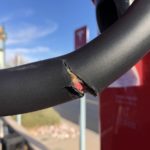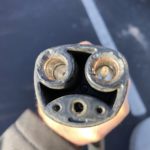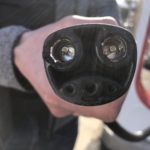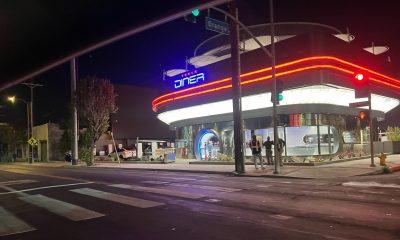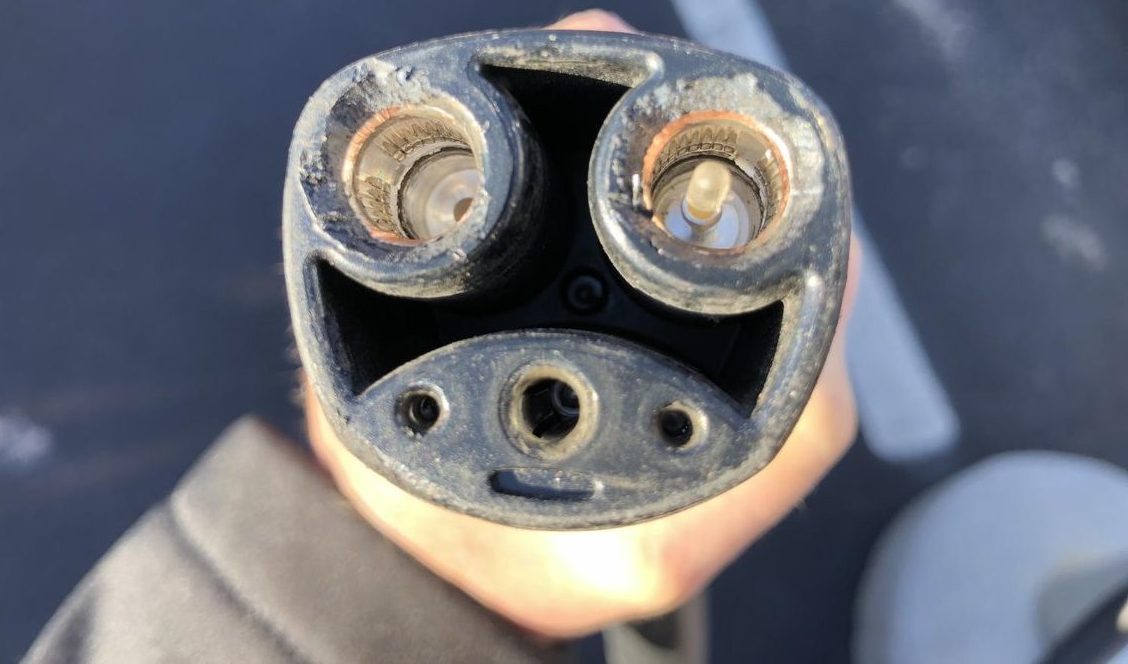

News
Tesla Supercharger attacked as vandals drill into charging plugs, partially sever cable
Led by disruptive vehicles like the Tesla Model 3, the electric car revolution is steadily gaining ground. Across the auto industry, new startups are focusing on electric cars, and veterans such as Porsche are committing to a future powered by sustainable energy. Unfortunately, as could be seen in recent incidents surrounding the Tesla community, it appears that there are still some groups who are showing resistance to electric vehicles as a whole.
Last December, a number of Tesla community members shared their experiences involving Superchargers being blocked by gas-powered vehicles. While some of these “ICE-ing” incidents appear to be the result of an honest mistake, some were undoubtedly intentional. Tesla owners u/Leicina and u/BarcodeOfficial from the r/TeslaMotors subreddit, for one, noted from their experience that some pickup truck drivers who were intentionally blocking Superchargers were verbally harassing EV owners.
While such ICE-ing episodes continue to be reported across the Tesla community, an incident recently shared by Model 3 owner-enthusiast Mark Larsen showed what could very well be one of the most direct acts against Teslas to date. As noted by Larsen, a Supercharger station at St. George, Utah — one of the company’s older charging locations — became the victim of an aggressive act of vandalism. During the incident, the vandals attempted to sever a Supercharger cable. The perpetrators drilled into the plugs of the charging stalls as well.
- (Photo: Mark Larsen/Twitter)
- (Photo: Mark Larsen/Twitter)
- (Photo: Mark Larsen/Twitter)
Tesla’s St. George, Utah Supercharger recently became the victim of vandalism. (Photo: Mark Larsen/Twitter)
As a result of the attack, the Model 3 owner noted that three of the Supercharger’s stalls became inoperable. Fortunately, there were some security cameras in the area. Thus, there is some hope that the culprits behind the Supercharger attack might eventually be apprehended. As noted by Larsen in his Twitter post, the incident has already been reported to Tesla.
While Tesla’s electric cars are beloved by many, the vehicles themselves remain polarizing to some members of the auto community. Apart from ICE-ing incidents and acts of vandalism against Superchargers, there has also been a rise in reports of break-ins involving the company’s vehicles. In the Bay Area and neighboring cities alone, some Tesla owners practically felt as if they were being targeted due to the frequency of attacks against electric cars.

While responding to a Model 3 owner whose vehicle was damaged while it was unattended, Elon Musk noted that Tesla would be rolling out a ‘Sentry Mode’ as an added security feature. Musk did not elaborate on the capabilities of Sentry Mode, though it is speculated that the feature would extend upon Tesla’s built-in dashcam solution and leverage the vehicles’ eight surrounding cameras for video recording versus one. In true Elon Musk fashion, the name Sentry Mode appears to be rooted in pop culture, being a feature of Iron Man’s redundant defense mechanism for JARVIS.
In a recent comment on Twitter, Elon Musk noted that Sentry Mode should roll out to owners who are part of the company’s beta testing program in two to three weeks. Considering the pervading negative sentiments from the anti-EV community today, Tesla’s Sentry Mode would definitely be a timely feature.
There is no doubt that the electric car revolution is starting. Inasmuch as resistance against EVs is likely to remain, there is very little that can be done to stop the auto industry’s transition to electric power, particularly as key markets such as Europe and China have both committed to a future powered by sustainable energy. Among automakers, Tesla’s disruption with the Model S, X, and 3 has all but encouraged veteran carmakers to push the development of electric vehicles, as evidenced by cars such as the Porsche Taycan and the Jaguar I-PACE. As electric vehicles become more prevalent, and as more automakers embrace sustainable transportation, one can only hope that resistance against EVs would eventually fade and die out.
Elon Musk
Tesla Supercharger Diner food menu gets a sneak peek as construction closes out
What are you ordering at the Tesla Diner?

The Tesla Supercharger Diner in Los Angeles is nearing completion as construction appears to be winding down significantly. However, the more minor details, such as what the company will serve at its 50s-style diner for food, are starting to be revealed.
Tesla’s Supercharger Diner is set to open soon, seven years after CEO Elon Musk first drafted the idea in a post on X in 2018. Musk has largely come through on most of what he envisioned for the project: the diner, the massive movie screens, and the intended vibe are all present, thanks to the aerial and ground footage shared on social media.
We already know the Diner will be open 24/7, based on decals placed on the front door of the restaurant that were shared earlier this week. We assume that Tesla Optimus will come into play for these long and uninterrupted hours.
The Tesla Diner is basically finished—here’s what it looks like
As far as the food, Tesla does have an email also printed on the front door of the Diner, but we did not receive any response back (yet) about what cuisine it will be offering. We figured it would be nothing fancy and it would be typical diner staples: burgers, fries, wings, milkshakes, etc.
According to pictures taken by @Tesla_lighting_, which were shared by Not a Tesla App, the food will be just that: quick and affordable meals that diners do well. It’s nothing crazy, just typical staples you’d find at any diner, just with a Tesla twist:
Tesla Diner food:
• Burgers
• Fries
• Chicken Wings
• Hot Dogs
• Hand-spun milkshakes
• And more https://t.co/kzFf20YZQq pic.twitter.com/aRv02TzouY— Sawyer Merritt (@SawyerMerritt) July 17, 2025
As the food menu is finalized, we will be sure to share any details Tesla provides, including a full list of what will be served and its prices.
Additionally, the entire property appears to be nearing its final construction stages, and it seems it may even be nearing completion. The movie screens are already up and showing videos of things like SpaceX launches.
There are many cars already using the Superchargers at the restaurant, and employees inside the facility look to be putting the finishing touches on the interior.
🚨 Boots on the ground at the Tesla Diner:
— TESLARATI (@Teslarati) July 17, 2025
It’s almost reminiscent of a Tesla version of a Buc-ee’s, a southern staple convenience store that offers much more than a traditional gas station. Of course, Tesla’s version is futuristic and more catered to the company’s image, but the idea is the same.
It’s a one-stop shop for anything you’d need to recharge as a Tesla owner. Los Angeles building permits have not yet revealed the date for the restaurant’s initial operation, but Tesla may have its eye on a target date that will likely be announced during next week’s Earnings Call.
News
Tesla’s longer Model Y did not scale back requests for this vehicle type from fans
Tesla fans are happy with the new Model Y, but they’re still vocal about the need for something else.

Tesla launched a slightly longer version of the Model Y all-electric crossover in China, and with it being extremely likely that the vehicle will make its way to other markets, including the United States, fans are still looking for something more.
The new Model Y L in China boasts a slightly larger wheelbase than its original version, giving slightly more interior room with a sixth seat, thanks to a third row.
Tesla exec hints at useful and potentially killer Model Y L feature
Tesla has said throughout the past year that it would focus on developing its affordable, compact models, which were set to begin production in the first half of the year. The company has not indicated whether it met that timeline or not, but many are hoping to see unveilings of those designs potentially during the Q3 earnings call.
However, the modifications to the Model Y, which have not yet been officially announced for any markets outside of China, still don’t seem to be what owners and fans are looking forward to. Instead, they are hoping for something larger.
A few months ago, I reported on the overall consensus within the Tesla community that the company needs a full-size SUV, minivan, or even a cargo van that would be ideal for camping or business use.
Tesla is missing one type of vehicle in its lineup and fans want it fast
That mentality still seems very present amongst fans and owners, who state that a full-size SUV with enough seating for a larger family, more capability in terms of cargo space for camping or business operation, and something to compete with gas cars like the Chevrolet Tahoe, Ford Expedition, or electric ones like the Volkswagen ID.BUZZ.
We asked the question on X, and Tesla fans were nearly unanimously in support of a larger SUV or minivan-type vehicle for the company’s lineup:
🚨 More and more people are *still* saying that, despite this new, longer Model Y, Tesla still needs a true three-row SUV
Do you agree? https://t.co/QmbRDcCE08 pic.twitter.com/p6m5zB4sDZ
— TESLARATI (@Teslarati) July 16, 2025
Here’s what some of the respondents said:
100% agree, we need a larger vehicle.
Our model Y is quickly getting too small for our family of 5 as the kids grow. A slightly longer Y with an extra seat is nice but it’s not enough if you’re looking to take it on road trips/vacations/ kids sports gear etc.
Unfortunately we…
— Anthony Hunter (@_LiarsDice_) July 17, 2025
Had to buy a Kia Carnival Hybrid because Tesla doesn’t have a true 3 row vehicle with proper space and respectable range. pic.twitter.com/pzwFyHU8Gi
— Neil, like the astronaut (@Neileeyo) July 17, 2025
Agreed! I’m not sure who created this but I liked it enough to save it. pic.twitter.com/Sof5nMehjS
— 🦉Wise Words of Wisdom – Inspirational Quotes (IQ) (@WiseWordsIQ) July 16, 2025
Tesla is certainly aware that many of its owners would like the company to develop something larger that competes with the large SUVs on the market.
However, it has not stated that anything like that is in the current plans for future vehicles, as it has made a concerted effort to develop Robotaxi alongside the affordable, compact models that it claims are in development.
It has already unveiled the Robovan, a people-mover that can seat up to 20 passengers in a lounge-like interior.
The Robovan will be completely driverless, so it’s unlikely we will see it before the release of a fully autonomous Full Self-Driving suite from Tesla.
Energy
Tesla launches first Virtual Power Plant in UK – get paid to use solar
Tesla has launched its first-ever Virtual Power Plant program in the United Kingdom.

Tesla has launched its first-ever Virtual Power Plant program in the United Kingdom. This feature enables users of solar panels and energy storage systems to sell their excess energy back to the grid.
Tesla is utilizing Octopus Energy, a British renewable energy company that operates in multiple markets, including the UK, France, Germany, Italy, Spain, Australia, Japan, New Zealand, and the United States, as the provider for the VPP launch in the region.
The company states that those who enroll in the program can earn up to £300 per month.
Tesla has operated several VPP programs worldwide, most notably in California, Texas, Connecticut, and the U.S. territory of Puerto Rico. This is not the first time Tesla has operated a VPP outside the United States, as there are programs in Australia, Japan, and New Zealand.
This is its first in the UK:
Our first VPP in the UK
You can get paid to share your energy – store excess energy in your Powerwall & sell it back to the grid
You’re making £££ and the community is powered by clean energy
Win-win pic.twitter.com/evhMtJpgy1
— Tesla UK (@tesla_uk) July 17, 2025
Tesla is not the only company that is working with Octopus Energy in the UK for the VPP, as it joins SolarEdge, GivEnergy, and Enphase as other companies that utilize the Octopus platform for their project operations.
It has been six years since Tesla launched its first VPP, as it started its first in Australia back in 2019. In 2024, Tesla paid out over $10 million to those participating in the program.
Participating in the VPP program that Tesla offers not only provides enrolled individuals with the opportunity to earn money, but it also contributes to grid stabilization by supporting local energy grids.
-

 Elon Musk1 day ago
Elon Musk1 day agoWaymo responds to Tesla’s Robotaxi expansion in Austin with bold statement
-

 News1 day ago
News1 day agoTesla exec hints at useful and potentially killer Model Y L feature
-

 Elon Musk2 days ago
Elon Musk2 days agoElon Musk reveals SpaceX’s target for Starship’s 10th launch
-

 Elon Musk3 days ago
Elon Musk3 days agoTesla ups Robotaxi fare price to another comical figure with service area expansion
-

 News1 day ago
News1 day agoTesla’s longer Model Y did not scale back requests for this vehicle type from fans
-

 News1 day ago
News1 day ago“Worthy of respect:” Six-seat Model Y L acknowledged by Tesla China’s biggest rivals
-

 News2 days ago
News2 days agoFirst glimpse of Tesla Model Y with six seats and extended wheelbase
-

 Elon Musk2 days ago
Elon Musk2 days agoElon Musk confirms Tesla is already rolling out a new feature for in-car Grok

